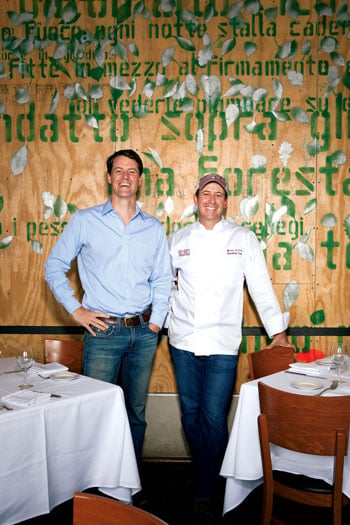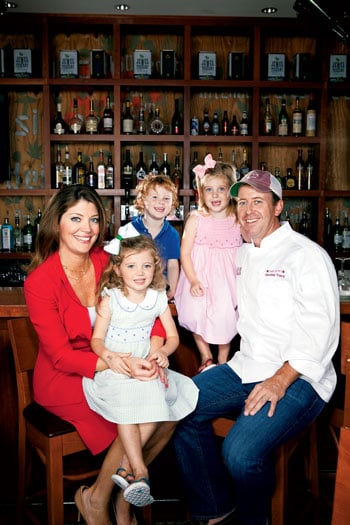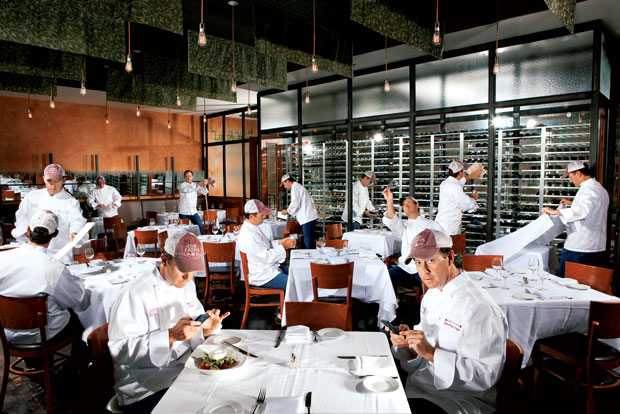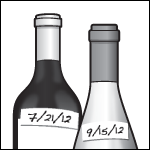The most remarkable thing about Geoff Tracy’s restaurants is
how unremarkable they are.
There’s nothing in the room or on the plate at any of his four
places in DC, Maryland, and Virginia to make you stop and take notice. No
nods to prevailing fashion, no gestures toward the latest trends and
concepts. And that’s precisely as Tracy has scripted it. At a time when
the restaurant scene has exploded but a great meal out is an uncertain
bet, his places trade on the comfort of the familiar and simple thing done
well.
You’re unlikely to remember your meal two weeks later. Heck,
you might not even remember it two hours later.
None of which is put forth as criticism.

Tracy himself would be the first to point out that his
restaurants are successful not because he’s a creative mastermind. His
mission statement is writ large on his awnings and menus: “Great food,
libation, merriment.” The phrase dates to 2000, the year he opened the
first of three Chef Geoff’s. The message: No aspect of the dining
experience should stand above the others; all three are equal. It’s a far
more populist sensibility than you might expect from a restaurant with the
word “chef” in the title. That’s Tracy.
One of the greatest compliments you can pay him is to tell him
you loved your recent dinner at one of his restaurants but you can’t
recall what you ate, who served you, or even, come to think of it, where
you dined. Consistency and seamlessness of experience are the enduring
virtues of Tracy’s restaurants, the reason he has managed, in a little
more than a decade, to build a company on its way to becoming a small
empire.
Like most successful restaurateurs, Tracy credits two decades
of experience, endless hard work, and a commitment to improving that
borders on obsession. But unlike most restaurateurs, Tracy places his
faith in a highly unorthodox system that confounds many of his brethren in
the business, a system that invites comparisons with the corporate tech
world in its devotion to data collection and with baseball’s current crop
of Moneyball GMs in its reliance on metrics and efficiencies. You’ve read
about artist chefs, businessmen chefs, and even CEO chefs. Meet the chef
as engineer.
Six-fifteen PM, Chef Geoff’s in Upper Northwest DC: You slip
into a corner booth. Elizabeth, the server, is agreeable in her smart tie
and pressed apron, the Pinot Gris is crisp and cool, the salmon with
lentils is perfectly cooked, the water glasses are kept filled, the check
comes without asking. Were you dining at one of Tracy’s spinoffs—Chef
Geoff’s in downtown DC or Tysons Corner, or even at the Italian-themed
Lia’s in Chevy Chase—your night wouldn’t be appreciably different.
Missteps in a Tracy restaurant are few. Things unspool
smoothly.
Here comes Tracy from the kitchen now, making the rounds, ball
cap cocked back on his head, his blue eyes gleaming. This is the public
face of his restaurants, the fun-loving guy down the block who opens his
home to the neighborhood for a nightly party.
It’s not at all a front, but as in his restaurants, what
matters most is what you can’t see. Compared with the level of detail with
which Tracy and his team watch your night unfold, you’re looking at a
black-and-white Philco and they’re staring at a high-def
flat-screen.
Did Elizabeth bring your Pinot Gris within three minutes of the
time you ordered it? Were your appetizers delivered within seven minutes,
entrées within ten, desserts within seven? Were these plates described at
the table before they were set in front of you? Were napkins refolded when
you went to the restroom? Was non-bottled water referred to as “ice water”
(correct) or “water” (incorrect)?
That couple sitting across from you picking at a plate of
hummus might be catching a light bite before a movie, or they might be
working secretly for Tracy. Once a month, he brings in anonymous reviewers
from an agency in New York to undertake a comprehensive evaluation of each
of his restaurants. One recent assessment noted ten small errors: A
dessert recommendation was offered only when the customer asked, and the
plate took ten minutes to arrive instead of seven; the sink in the women’s
room needed cleaning; bottled water wasn’t offered. Still, the restaurant
scored 93 out of 100 points.
When Tracy is in the kitchen he, too, is gathering data,
snapping photos of the tuna tartare appetizer on his iPhone to share with
managers at his other locations to make sure the plating is consistent,
the baked-wonton garnish jutting upright the way he wants. From the
kitchen at Tysons, his roving director of food and beverage, Wil Going, is
performing the same quality control, shooting pics of the shrimp and
grits, the bestselling item on Chef Geoff’s menu, and the mushroom
ravioli, the most profitable.
On this night, a member of Tracy’s team is finishing up her
exhaustive, bimonthly sweep of the original Chef Geoff’s on New Mexico
Avenue, Northwest, assessing the staff’s performance on 800 “standards”
that break down the daily business of a restaurant into discrete
measurements. Are all items chilled to 70 degrees before being placed in
the walk-in refrigerator? Are wines by the glass dated to ensure
freshness, and are they less than two days old? Is the dishwasher’s final
rinse set at the proper temperature?
Tracy’s team converts this information to numbers, which are
then crunched to compile weekly reports and later monthly and a quarterly
report cards.
All this orchestrated oversight to keep a low-key neighborhood
restaurant—a place that sits several rungs below the pampered refinements
of Citronelle or CityZen—running smoothly?
“Consistency,” Tracy says, “is a lot harder than it looks. It
might just be the hardest thing of all to achieve.”
When members of Tracy’s management team talk about their time
in the business, they speak of two distinct periods: before Tracy and
after Tracy.
These are industry veterans who have worked for some of the
biggest names in Washington, yet listening to them compare their
experiences, you might think they had come not just from different
companies but from different industries.
“When I came to work for Geoff, I thought I knew how to do my
job,” says one. “But then I came here and learned I could do it
differently and better. And I grew.”
“Does it sound like we’re all drinking the Kool-Aid?” another
asks, laughing. “Well, we are. There’s a lot to drink.”
To go to work in one of Tracy’s restaurants is to join one of
the most organized, forward-thinking, technologically advanced operations
in the local industry.
Most restaurants train employees for two weeks. At Tracy’s
restaurants, education is constant. Every dish at every restaurant—more
than 1,685 items—is digitized, with links to recipes and information for
servers. There are custom-made training videos on everything from how to
tourné a potato to how to enter an invoice. The emphasis on doing things
precisely is one reason you’ll never hear a server say, “Are you finished
with that?” The gracious “May I clear the plate?” is drilled into all
waiters.
Tracy finished first in his class at the Culinary Institute of
America—after graduating from Georgetown—but half of his cooks have no
formal training. Most staffers on the floor have either limited experience
or came from systems antithetical to Tracy’s.
Tracy’s team has broken down his operation into 70 training
courses—from cost control to “Wines of Italy”—along with comprehensive
tests and rigorous study sessions for those tests. Anyone scoring more
than 90 and in the top three in their class earns a $500
bonus.
“Empire” sounds like a grandiose word for a guy as unassuming
as Tracy, but he says volume has always been a core component of his
vision.
Until very recently, that meant the size of his restaurants and
not the number. He’s eager to see whether his ideas, his system, will
translate to a bigger operation. Next month, he opens a Chef Geoff’s in
Rockville. There are plans to add another five restaurants by 2020, a
number that would bring him close to that of the Clyde’s Restaurant Group,
which currently owns 14. The idea of becoming a recognizable local brand
drives him. But for the head of a small company with no investors, it also
brings moments of despair.
Expansion has already made it harder to adhere to his original
vision of high-volume restaurants with the sort of details in the dining
room (white tablecloths, servers in ties) and on the plate (high-quality
ingredients, a globally inspired menu) associated with fine-dining places
while pricing himself competitively with the likes of
Applebee’s.
With a single restaurant, it was possible not only to run the
kitchen but also to make the rounds of the dining room, checking up on
servers, offering diners the personal touch that distinguished his
restaurants from the corporate chains. Friends and coworkers still laugh
at stories of Tracy in the early years, watering the garden at midnight
after a 15-hour day in the kitchen.
Two restaurants—he opened the downtown one in 2002—meant
shuttling back and forth constantly. Three, which he undertook in 2006,
nearly broke him.
The fact that number four, Tysons in 2009, went relatively
smoothly does nothing to assuage his unease about number five.
Not that you’d see it under the cover of his dude-on-the-patio
smile.
Tracy, 39, didn’t burn to be a chef. He didn’t burn to be
anything at all.
He was a Boy Scout growing up in Hartford, Connecticut, three
blocks from a golf course. Rebellion amounted to sneaking onto the course
at night to practice putting and guzzle beer. He excelled at boarding
school and had an array of interests but lacked a focused passion. At
Georgetown, he majored in theology and spent his time pondering the nature
of happiness, inspired to contemplation by Professor Joseph Murphy’s
course “The Problem of God.”
Turns out Tracy could give a practical seminar on the subject
of happiness.
“I’m incredibly lucky,” he says. “I won’t ever say that I’m
not.”
He married his college sweetheart, Norah O’Donnell, now chief
White House correspondent for CBS News. They met his freshman year.
Catching sight of her and her roommate in line one day at the cafeteria,
he and a buddy from boarding school spent several minutes in anxious
consultation, wondering what their “angle” was going to be.
No angle necessary. The angle was niceness.
Tracy and O’Donnell have been together more or less ever
since—21 years now. It is, by all accounts, a storybook life.
They have three adorable kids and a seven-bedroom, nine-bath
Colonial in DC’s Wesley Heights, near American University. They bought it
for $3.2 million in 2010, the same year they published Baby Love:
Healthy, Easy, Delicious Meals for Your Baby and Toddler, a
bestselling cookbook. If he wanted to, Tracy could walk every day through
tree-canopied streets to work—his small suite of offices is upstairs from
the Chef Geoff’s on New Mexico Avenue.
The couple has been spotted working out at the gym together,
holding hands between sit-ups. Many nights, Tracy can be found not in one
of his kitchens but by O’Donnell’s side at a prestigious gala or dinner
party. One of Washington’s A-list couples, the duo is in high demand from
September to May.
Tracy confesses to frequent pinch-me sessions: “Have I gamed
the system? Are you supposed to be having this much fun? And making money
doing it? I’ve got great, healthy kids and a phenomenal wife who’s
exciting to me. Because of her, I get to hang out with the President of
the United States, or the Vice President. And doing charitable events. And
getting recognized in grocery stores. As a kid, I dreamed about being
shortstop for the Red Sox, but you know? This is up there.”
Many of his fellow chefs struggle with the guilt of rarely
seeing their children—sometimes naming their restaurants after them to
compensate—but there’s none of that tortured tone in the way Tracy talks
about his kids. He’s not not-around; he’s there. He’s
involved.
“I’m envious of him,” O’Donnell says. “Geoff is a good manager
at work, and he’s also a great manager of his time—managing his daily
schedule to work out every day the way he does, and work hard and run the
restaurants and be with the kids.”
A nanny and an au pair help, but so does Tracy’s willingness to
take time off. Among the many benefits of having an efficient,
high-functioning system is that it enables him not to have to be around
all the time. Tracy takes frequent advantage, recharging at a “destination
club” owned by former AOL chair Steve Case, called Exclusive Resorts. The
club’s initiation fee is $170,000 and permits executives to rent
properties for $1,000 a day in places such as Vail, Colorado, and Los
Cabos, Mexico. Tracy used all 30 days of his membership last year and
recently signed up for the company’s new, cheaper offshoot, Portico, to
increase his options.
In upper Northwest DC, he’s something of a folk hero for a
recent stunt that landed him in the gossip columns. A newly installed
speed camera nailed his Lexus three times in three days for exceeding the
posted limit. In all, 11,000 tickets and 20,000 warnings were issued to
drivers in the first two months the camera went up. “All y’all that live
in upper Northwest DC and drive on Foxhall Road . . . watch out for the
new speed camera,” Tracy wrote in an e-mail blast to his customers. “It’s
on a downhill so it gets you every time.” He wrote checks for $425, then
hired a guy for $1,200 to stand on Foxhall Road with a sign alerting
motorists to the trap. The back of it read: HAPPY HOUR AT CHEF
GEOFF’S.

Does it trouble Tracy that he gets written about mainly for
being his wife’s date at high-profile functions and for his efforts to
help his fellow citizens avoid tickets?
He laughs.
Or the fact that none of his restaurants has ever made a
Washingtonian 100 Very Best or Cheap Eats list?
“Yeah, what’s up with that?” he asks. More
laughter.
To make either of those lists, he knows, would require
ratcheting up the level of sophistication on the plate and in the room or,
alternatively, scaling back to deliver the sorts of values mom-and-pop and
ethnic restaurants do.
“I know what I am, and I know what kind of restaurants I want,”
he says. “I’ve never wavered on that.”
In other words, he minds the middle. And he minds it as few in
this city ever have.
“I’d be lying if I said I expected any of this,” Tracy says,
eating a crabcake lunch at Chef Geoff’s Downtown. “I honestly never
dreamed there’d be more than the one restaurant.”
This aw-shucks aspect is one of the things that make Tracy so
likable. He’s a bracing palate cleanser compared with the complex stews
offered up by many chefs, with their unchecked egos and unslakable thirst
for attention and validation. Mr. Smith, minus the passion and
ideology.
Tracy arrived in Washington in 1991 without the slightest clue
about what he wanted to do, much less become: “Direction? The last thing I
contemplated was direction.”
It put him out of step with his careerist classmates at
Georgetown, who four years later were bragging about the jobs they’d
landed at companies like Lehman Brothers. “What’s Lehman Brothers?” he
recalls asking.
But Tracy wasn’t without some foundation. He had worked at a
student-run store called Vital Vittles selling Triscuits, ice cream, and
other college necessities, working his way up from stock boy to general
manager of the campus organization that ran the store and other student
enterprises, overseeing a business of 85 employees that made $2 million to
$3 million a year.
In high school, he had bussed tables at the bistro Max on Main
in Hartford, and when a fellow busboy was canned for dealing cocaine,
Tracy went to owner Richard Rosenthal with an offer: “Rich, I can handle
the whole restaurant. You don’t have to hire anyone else.”
Rosenthal was skeptical, but Tracy made good on his
promise.
When Tracy was headed off to college, Rosenthal sat him down
for a talk: “You did really well. You’re gonna go on and become a doctor
or lawyer, and that’s great—you should. Stay the f— out of the
restaurant business.”
“Why?” Tracy asked.
You’re very dedicated, Rosenthal said. You’re nice. The
business will chew you up. It’s harder than you know.
After Georgetown, Tracy and O’Donnell, over the objections of
her Catholic parents, moved into an apartment together in DC’s West End
and began looking for work. On his cap at graduation, he wrote: will work
for food. It turned out to be a case of truth in jest.
Tracy worked his connections to snag a job as host at the Old
Ebbitt Grill—the raw-bar emporium is owned by the Clyde’s Restaurant
Group, whose president, Tom Meyer, is a family friend—then moved on to
Clyde’s in Chevy Chase, where he worked the fry station, manned the grill,
plated desserts. At lunch he waited tables at Cafe Deluxe. It was a grind,
as Rosenthal had said. But more exposure didn’t dim his eagerness. When he
wasn’t working, he was reading cookbooks. He was wowed by what some chefs
could do.
He entered the Culinary Institute of America in 1996. Tracy
quickly learned his limitations, but also his strengths. Other students
could do things at the stove he couldn’t, but he had a gift for seeing the
needs of the entire operation.
When, during a business course, an instructor bewildered a
class by defining a restaurant as “a business open to the public that
serves food and beverage for the sole purpose of making money,” Tracy was
the only one nodding along and not asking, “But what about the chef as
artist?”
“It struck me as profound,” he says.
Halfway through CIA, he served a three-month externship at
Roberto Donna’s Galileo, at the time one of Washington’s top restaurants.
To be the best, Tracy thought, you have to learn from the
best.
Galileo was an education—in what not to do. Purveyors were
strung along with a hundred excuses as to why they weren’t being paid.
Shelves of high-priced food were going to waste. The kitchen was tense,
full of shouting.
I don’t want to run a place like this, Tracy thought. There has
to be another way.
He might never be a great chef, but he knew what he could
do—and in the end, he suspected, that might be more important. He
understood how to lead people, and he understood how to create a
system.
After graduation he worked as floor manager at 1789, also owned
by the Clyde’s group.
One day he approached Meyer. “How many years should I work in
kitchens before I open my own place?” he asked. “Five? Ten?
Fifteen?”
“I usually talk people out of the restaurant business,” Meyer
recalls. “But Geoff just had a passion for it, and he was really smart and
really talented.”
“The time is right now,” Meyer told him. “If you wait 10 to 15
years, you’re gonna have a wife, a mortgage, a dog. What’s your net
worth?”
Tracy wanted to laugh. Or cry. “Fifteen-hundred dollars,” he
said.
Meyer advised him to forget about opening the sort of place
most sous chefs dream of—the intimate bistro where they can express
themselves at the stove: “You’ll be working six nights a week and burned
out in five years.” Instead Meyer urged him to open a bigger, high-volume
restaurant where Tracy could take full advantage of his understanding of
operations.
In the winter of 1999, Tracy agreed to take on the debt of one
of Donna’s satellites, Dolcetto, complete with a freezer of rotting meat
and a rear-wall mural of the chef framed in ivy and flanked by cherubs. It
had just gone out of business.
Three of Tracy’s CIA classmates—including a current executive
chef, David Pow—leapt at the chance to work for him, despite being warned
that they wouldn’t be paid until after the place opened.
Tracy was blessed, also, with an eye for talent. A guy he’d
hired to work the salad station turned out to be an exceptional cook.
Tracy promoted him twice, making him executive chef overseeing the kitchen
at Chef Geoff’s downtown. Great chefs often speak of a grueling
apprenticeship in a Michelin-starred restaurant in Paris followed by
several years of study in a succession of four-star restaurants in the
States. But after only a couple of years under Tracy, a 24-year-old Johnny
Monis struck out on his own and open DC’s acclaimed Komi in
2003.
Tracy’s obsession with systems was born not of the forethought
and planning on which he now prides himself but of necessity. Really, of
desperation.
Lia’s, which opened in 2006, was the first restaurant he
launched that didn’t take over an existing place, a mistake he vows never
to repeat. Build-out costs exceeded estimates, and the job dragged on.
Lia’s struggled in the first few months, and the two Chef Geoff’s were
struggling, too. He worried about keeping all three places afloat. Some
nights, he hardly slept. It was, he says, the worst time of his life, “a
total meltdown.”
He cursed his younger, cockier self as he recalled the words of
his commencement address at the Culinary Institute of America: “When
things become too comfortable, that’s precisely the time to change and do
something else. When your heart’s pumping and you’re really scared, that’s
when you’re really living life.”
His heart was pumping, all right. It had never pumped harder.
Scared? He had never been more scared in his life.
His father, Dan, heard it in their nightly phone conversations.
A retired CPA from Arthur Andersen who gave the books a once-over every
month, he listened to Tracy pour out his frustration and fear one night.
He told his son, “You need to hire your brother.”
My brother? Tracy thought. I should hire a
teacher?
Chris Tracy had worked for Teach for America; had taught
English as a Second Language at DC’s Shaw Middle School at Tenth and U
streets, Northwest; and had just abandoned a PhD program at Johns Hopkins
in sociology. He was uncertain what to do with his life, and while that
meant he’d likely be available, nothing on his résumé suggested he would
be an asset to the company.
But Tracy trusted his father in business matters, and the more
he mulled the idea, the more he thought Chris might be useful.
In September 2006, Geoff brought his brother aboard for what he
figured might be six months, until Chris grew bored or restless. But the
restaurant novice was a quick study, and he liked the work, the
gamesmanship, the idea of competing every day. It was one of the few
things the brothers had in common.
Geoff was a big-picture guy. In college, he had loved the intro
courses, the big ideas, but got bored when he was forced to delve deeper
into a subject. Chris, on the other hand, lived to, as he puts it, “drill
down into the details,” examining the contradictions of things, exploring
their many shades of gray.
Geoff wasn’t so proud that he couldn’t admit that where he was
weak, Chris was strong. Also that where Geoff was weak, the company itself
was weak. He couldn’t keep doing things the old way. He needed a new
system. It would be like starting over again.
Forced to reckon with the kind of restaurateur he wanted to be,
he would forge a new kind of company. Out of the chaos would emerge a new
order.
Chris Tracy sits staring at his two computer screens at 9 am
one morning at company headquarters while Sarah Murphy, the company’s
“executive director of profitability,” feeds him numbers from a sheet of
paper filled with so much data, so minutely recorded, that she has to use
a ruler to make sure she’s read the correct line. By the end of the hour,
he’ll be bleary-eyed. By 2, he still won’t have had lunch.
Downstairs, Geoff makes the rounds of the kitchen—sampling
dishes, snapping pictures, asking after his cooks. He’s performing one
kind of control: a human, tactile interaction. Chris performs another:
detached, numerical.
“We’re both analytical guys, but we’re different analytical
guys,” Geoff says. “I barely understand the things he’s
doing.”
To see Chris preside over a meeting is to see a manner more
classroom than corporate. Lean, dark-haired, and intense, he could hardly
present a more obvious contrast with his brother. His authority derives
less from his need to assert his power than from his willingness to
listen. He doesn’t assert; he asks. He encourages. He challenges. If he’s
reluctant to give the impression of being “top-down” in his management
style, he has no such qualms about being perceived as a wonk. He speaks
excitedly of “data points.” The words “super-actionable, super-precise
data” roll off his tongue.
The numbers Sarah gives him to punch into his spreadsheets
enable him to compile a weekly report for managers at all the restaurants.
The report is a distillation of what he discovers in the surveys completed
by diners on the website OpenTable, along with a graph tracking the trends
at each restaurant (in food, in service) that he distributes to all
managers and an update on the progress they’re making toward their
budgets.
“I don’t think just measuring is what differentiates us,” Chris
says. “What differentiates us is that we share that information with our
managers in a way that is actionable, so that they can drill in and find
out what’s wrong and make intelligent decisions.”
Recent scrutiny of a spike in bar-supply costs at one
restaurant revealed that a manager had been spending too much on mints. A
small cost, perhaps, but it’s minding the little things, Chris suggests,
that distinguishes a successful company from a struggling one.
Later will come monthly, company-wide progress reports—one for
hospitality, one for profitability—and an even more comprehensive
quarterly “report card.”
The report-card numbers are gleaned from three sources. The
work of the New York-based company, Coyle Hospitality Group—hired to visit
each restaurant anonymously every month and assess each aspect of the
dining experience—is converted into hard numbers. The same conversion is
made for the OpenTable surveys. (A diner’s 4, for “very good,” is recorded
as “80%.”) The third set of numbers is taken from the spot checks
performed by members of Tracy’s management team using the 800 standards.
From the 26-page score sheet, it hardly seems possible that Chris might
have overlooked some detail of the restaurant operation.
Chris believes it’s simply not possible to measure too much.
Measurements matter. They improve performance. It’s not a stretch, he
seems to suggest, that if your burger or salmon is cooked right and you
find the staff friendly and attentive, numbers played at least some
role.
The numbers are important in other ways, too. The company’s
incentive program is tied to the stats Sarah Murphy feeds him. Servers who
score a 90 or above from the converted Coyle numbers earn a $250 bonus.
Among the managerial staff, the crucial number—the one they all anxiously
await—is the score on the quarterly report card that measures the rate of
profit relative to the previous year’s quarter. A positive number, and the
managers take home 40 percent of the profit growth; one year, a manager
earned $30,000 for three months’ work.
I spoke to several chefs and managers about the Chef Geoff’s
model—its reliance on data, its elevation of numbers over the “eye test.”
None had heard of anything like it. Some reacted with wry amusement, some
with “hey, whatever works” astonishment.
“Numbers are just tools,” Chris Tracy says when we sit down to
lunch at Chef Geoff’s downtown. “The idea is to get better. To constantly
improve.”
He emphasizes that the numbers grow out of questions, that the
struggle to become more efficient is what propels the data collection, not
the other way around. It’s not, in other words, measurement for
measurement’s sake. Quite the opposite: He’s looking to turn what’s
commonly perceived to be instinctive into something that can be broken
down and quantified.
Chris says they have yet to reach the goals they set several
years ago: a 15-percent profit margin and a score of 95 or higher on the
Hospitality Report Card (a number calculated over the course of the year
and encompassing the scores of all the restaurants). The company ended
last year with a 10.2-percent profit margin and a score of
89.5.
A disappointment, Chris says. One that drives him and the
team.
But there’s no doubt, he adds, that all this number-crunching
is worth it.
In 2001, in its first full year, Chef Geoff’s made just over
$132,000. Last year, the four restaurants earned a profit of just over
$1.1 million. In 2008, the year Coyle began its anonymous visits, the
company-wide score was 80. Last year: 89. The OpenTable surveys have
steadily improved, too, since Chris and his team began tracking them,
rising from 75.3 in the second quarter of last year to 79.5 in the first
quarter of 2012. All four restaurants are profitable, and none carry
debt.
When Rockville opens, the company will have about 70 more
employees to oversee and a 20-percent larger company to manage. It will be
harder than ever for Geoff or Going to visit all the company’s restaurants
in a day, which means it will be harder to maintain daily contact with the
kitchen, to give the constant oversight that helps ensure that dishes are
sent out the same way every time. It means more product to order, more
employees to hire and train, more data to crunch.
And that means trusting as never before in their systems, even
as those systems are being tested as never before.
With Rockville very much on his mind, Chris sits down with
Murphy and Courtney Fitzgerald, the head of hospitality, one recent
morning for a conference call with a software company called iCIMS
headquartered in New Jersey. They huddle around his corner desk. A guy
named Jim is on the other end.
The idea that there exists a single program that might fit all
their number-crunching needs has long haunted Chris’s
thoughts.
“One of my frustrations right now is with our managers’ logs,”
he tells Jim. “There’s a ton of great information that goes into those
logs but not a lot of great analysis.” His managers are doing a good job
of recording pertinent details of their operations. But there’s no easy
way to process that information and make use of it. He concocts a
ridiculous for-instance of the kind of data collection he’s interested in
seeing—a nightly “weather report” from each location.
“Sure,” Jim says with a laugh, “that’d be
possible.”
“And you’re saying you could run reports on the number of
cloudy days?”
“Agreed.”
This pleases Chris, and he looks around the room at the others,
nodding; iCIMS appears more attractive than he anticipated.
Could iCIMS tailor a program to their specific
needs?
It could.
And a different program for each restaurant?
Sure thing.
“What we would do,” Jim says, “is we would have to build those
documents for you. We give you five forms free, and you can go from
there.”
Five forms? To measure everything they need to measure? To
analyze what’s selling on the menus and what’s not? To record the time
between when a dish is ordered and when it arrives, and how long it takes
between appetizer and entrée?
“I’m envisioning about 342 forms,” Chris says.
Jim, hearing hyperbole, laughs.
Chris isn’t laughing.
Geoff breaks into a grin when the conversation is relayed to
him later.
His response underscores an essential difference between the
brothers. What for Chris is a source of frustration is for Geoff one of
those instances in which the seeking is as important as the finding. His
sunniness seems to say: We will find the answer eventually. What’s
important is that they not accept the status quo, that they’re constantly
looking for ways to become more efficient, more consistent.
They sit across from each other in the office, Geoff leaning
back in his T-shirt and ball cap, Chris leaning forward in his crisp,
collared shirt.
Chris is intent on making clear to me that he doesn’t believe
they’ve created a perfect system. They never speak of the structure in
place as if it’s inviolable, complete unto itself—as if they’re content
that they’ve found The Way.
“There is no way,” Chris says. “And that’s the frustrating
thing, obviously. But it’s also the fun of it.”
The fun of it?
“The challenge of it—that’s fun.”
Geoff says, “Figuring it out, like you have to figure out a
game. I think that’s what keeps it interesting.”
“Definitely,” Chris says.
They could be back at their childhood house in Hartford, a
couple of boys bonding over some brotherly interest only they understand.
Rockville looms, and beyond it, five more restaurants over the next eight
years, but they have a yin and a yang to control the chaos.
“I always say,” Geoff says, “if I’m not enjoying it, I’m not
going to keep doing it.”
“Exactly,” Chris agrees.
“It’s work. It’s constant. It never ends. But it’s got to be
fun, too.”
Fun: the 801st standard?
The brothers roar.
Todd Kliman, the magazine’s food and wine editor, is a James
Beard Award-winning food critic and author of “The Wild Vine: A Forgotten
Grape and the Untold Story of American Wine.”
























